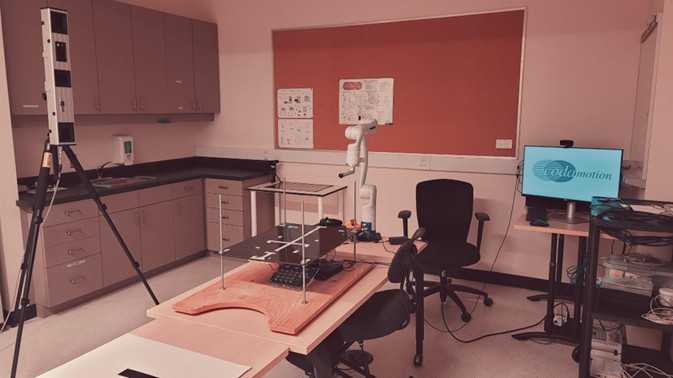
Examining the Multisensory Contributions to Sensorimotor Control in Humans
The team at the Sensorimotor Exploration Lab at Queen’s University (Ontario, Canada), led by Dr Gerome Manson, conducts research across a wide range of areas relating to human motor control. These include: sensory contributions to motor control, motor learning, movement perception, and memory.
A compact setup consisting of a single Codamotion CX1 and CodaHub is used to record 3D movement information and to trigger robotic devices in real-time. The lab combines this with other neurophysiological recording tools to explore how environmental sensory information contributes to movement planning and control.
The team favours Matlab as their primary platform for real-time experimental control and recording. They have therefore made extensive use of Codamotion’s SDK options to relay data from their Codamotion system directly to Matlab during acquisition and for post-acquisition download. This allows real-time experimental manipulations such as haptic robotic perturbations and the presentation of other visual or tactile stimuli, all controlled and processed within the same familiar software environment. This platform can be deployed across many different studies, and the lab has kindly provided details of some of these to be shared here.
PhD student, Sadiya Abdulrabba, is using the system to track rapid movement corrections to changing target locations as participants reach to different sensory targets (e.g., tactile, visual, somatosensory). Sadiya is interested in examining whether the sensory modality of the target affects how quickly and how accurately humans can make movement corrections.
Another ongoing project by undergraduate kinesiology student, Nick Butler, uses the same tracking system in combination with electro-oculography and electroencephalography to investigate how visual objects in the action space affects movement accuracy.
In addition to multisensory studies, the Codamotion system is used to assess speed-accuracy trade-offs. Capturing movement times for movements of varying difficulties is the focus of undergraduate kinesiology student, Jasmyn Lee. Using the well-established Fitt’s Law paradigm in combination with qualitative research methods to explore barriers to research participation for community members outside of the University.
Master’s student, Anisa Hassan, and undergraduate health sciences student, Obaida Al-Naib, use robot-guidance to assist people in writing unfamiliar texts. The objective of this work is to compare the effects of active and passive movements on memory of written text. In this context the Codamotion system is assisting with trajectory generation.
The Sensorimotor Exploration Lab demonstrates the wide variety of research and flexibility of use that can be achieved even with the most compact of Codamotion systems, and we thank the researchers at Queens University for sharing details of their projects with us.